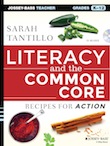Writing Good Objectives: Purpose Is Paramount
 By Sarah Tantillo
By Sarah Tantillo
In my MiddleWeb post, How to Avoid Kidnapping Your Students, I talked about what I call RPM – the why and how of writing Rigorous, Purposeful, and Measurable objectives. This post explores why presenting a clear and compelling purpose for lessons is the critical first step in creating good objectives .
Why Is “Purposeful” So Important?
One day, sitting in the back of a sixth-grade ELA class, I watched a teacher deliver a lesson called “Transforming Simple Sentences into Compound Sentences Using FANBOYS.”[1]
She hooked the students with a question about several nose-wrinkling sentences:
What do you notice about the following sentences?
|
Students answered the “What do you notice?” question in various ways (from “They all talk about sweat” to “The third one suggests 
As I watched, I thought to myself, This is good, but they are not getting why we use different sentence structures. And if they don’t get that, they won’t use them in their own writing.
If you don’t establish the purpose for the work, students might be compliant and attentive in your class, but they will not know why they are considering, for example, different forms of sentences. They won’t know that you are trying to train them to become more effective writers who vary sentence structure for maximum impact. And punch.
If we want them to apply this information in their own reading and writing, we need to make it clear from the beginning of the lesson that this is the objective of what we are learning today. Moreover, students retain more when they see the purpose for the information they are studying.
In short, the “P” in “RPM” ensures that we make the sales pitch and clarify our purpose(s) for the work.
Make Sure the Purpose Is Relevant
One day I observed a social studies teacher who tried to sell students on the value of studying geographical regions with the pitch: “Look at the cover of your textbook. What’s the title? Right: ‘Horizons: States and Regions.’ So if you don’t know what ‘regions’ are, you won’t understand what your textbook is about.” Sitting in the back of the room, I thought, That’s true and a fair point, but I’m not sure it would get anyone out of bed in the morning.

In fact, he hadn’t been pleased with the whole lesson. He’d relied too much on the textbook. “The kids were bored. I was bored. It was awful.” He shook his head.
This led me to ask him: “How would you have set the purpose if you hadn’t had the textbook?”
We talked about it, and this is what we came up with. He could have said, for example: “When you grow up, you’re going to get a job, and you’re going to be able to choose where you want to live—especially if you get a good education so you can have the freedom to decide where you want to work and where you want to live. And there are different kinds of regions that you can choose from, so that’s why we’re going to look into them today….”
See, it’s not enough to have just any purpose. It has to be relevant, so the students can see what’s in it for them. And as much as possible, they need something to look forward to: a life full of freedom, choices, and promise.
Why “In Order To”?
One day while attempting to write RPM objectives for her next week’s lesson plans, a teacher asked me if it was OK to use “by” instead of “in order to” to convey the purpose for the lessons.
Here is what I told her: The word “by” answers the question “How?”—not the question “Why?”

But “by” does not answer the question “Why?” so it does not address the purpose of the objective. Therefore you must use “in order to” if you want to convey the purpose. Here are some objectives that show this distinction:
- SWBAT identify and describe a character’s actions IN ORDER TO draw inferences about the character.
- SWBAT draw inferences from chapter #___ of ___________[title of text] IN ORDER TO make predictions about the characters’ behavior and the plot.
- SWBAT ask questions about __________[title of text] IN ORDER TO generate ideas and explanation about the author’s arguments/messages.
A final thought: As you draft your RPM objectives, it would be great to compare notes with colleagues who teach the same grade(s). Developing common purposeful objectives that address the Common Core literacy standards across different subject areas should help your students meet and exceed those standards.
[1] “FANBOYS” is an acronym for commonly-used coordinating conjunctions: for, and, nor, but, or, yet, so. See Jeff Anderson’s Mechanically Inclined: Building Grammar, Usage, and Style into Writer’s Workshop (Portland, ME: Stenhouse Publishers, 2005), 86.
_____
Adapted from Literacy and the Common Core: Recipes for Action (Jossey-Bass, 2014).




































Good reminders! Thank you for sharing.